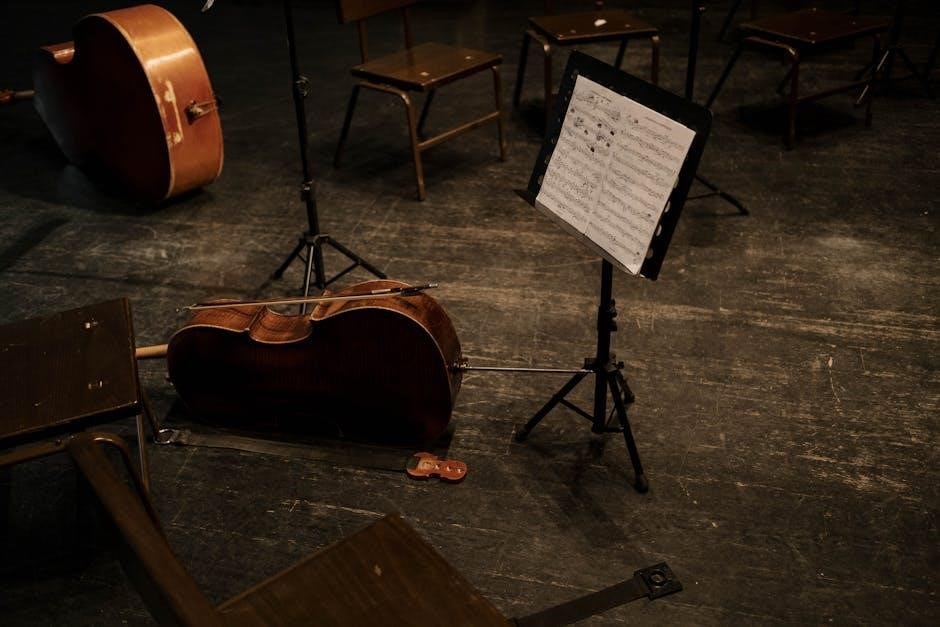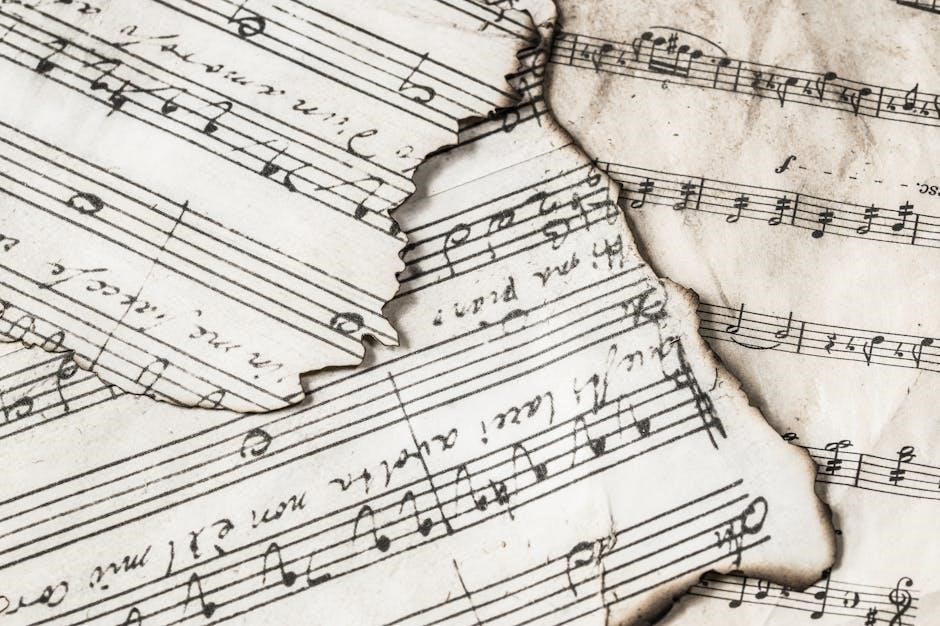
liszt etude no 6 sheet music pdf
Liszt’s Etude No․ 6‚ part of the Transcendental Etudes‚ is a technically demanding piece based on Paganini’s Caprice 24․ It offers rich interpretive possibilities for pianists‚ blending virtuosity with musicality․ Sheet music is widely available in both free PDF downloads and paid editions‚ making it accessible for study and performance․
1․1 Overview of the Etude
Liszt’s Etude No․ 6 is a celebrated piece from his Transcendental Etudes‚ known for its technical challenges and interpretive richness․ Based on Paganini’s Caprice 24‚ it demands mastery of various techniques like rapid arpeggios and intricate finger dexterity․ The etude is both a technical showcase and a deeply expressive work‚ offering pianists the opportunity to explore its dramatic contrasts and lyrical passages․ Its availability in PDF and MIDI formats makes it accessible for study and performance‚ ensuring its place in classical piano repertoire․
1․2 Historical Context
Liszt’s Etude No․ 6‚ part of the Transcendental Etudes‚ was composed between 1837 and 1852․ Originally based on Paganini’s Caprice No․ 24‚ it reflects Liszt’s admiration for Paganini’s virtuosity․ The etude underwent significant revisions‚ with the final version showcasing Liszt’s mature style․ Its programmatic elements and technical brilliance made it a cornerstone of Romantic piano repertoire․ The piece highlights Liszt’s ability to blend technical demands with expressive depth‚ solidifying its historical significance as a benchmark for pianistic achievement․
1․3 Popularity and Significance
Liszt’s Etude No․ 6 is renowned for its technical brilliance and expressive depth‚ making it a benchmark for pianists․ Its popularity stems from its availability in various sheet music formats‚ including free PDF downloads‚ ensuring accessibility for performers and students․ The etude’s significance lies in its technical and interpretive challenges‚ showcasing Liszt’s mastery of Romantic-era virtuosity․ It remains a cornerstone of piano repertoire‚ admired for its blend of technical demands and emotional resonance‚ solidifying its enduring appeal and influence․

Structure and Composition
Liszt’s Etude No․ 6‚ from the Transcendental Etudes‚ is based on Paganini’s Caprice 24․ It features complex arpeggios‚ scales‚ and technical demands‚ showcasing virtuosic brilliance in A minor․
2․1 Musical Form and Structure
Liszt’s Etude No․ 6‚ based on Paganini’s Caprice 24‚ exhibits a clear thematic structure with variations․ The piece begins with a dramatic theme in A minor‚ followed by intricate variations that showcase technical brilliance․ Each variation introduces unique challenges‚ such as arpeggios‚ scales‚ and double notes‚ while maintaining a cohesive musical narrative․ The etude’s form is tightly knit‚ blending virtuosic elements with expressive depth‚ making it a hallmark of Romantic-era piano literature․
2․2 Technical Challenges
Liszt’s Etude No․ 6 presents formidable technical challenges‚ including rapid arpeggios‚ double notes‚ and intricate finger dexterity․ The piece demands precise control over dynamics and articulation‚ with wide stretches in the right hand that require careful hand positioning․ Pianists must master varied touch and phrasing to navigate the etude’s virtuosic passages seamlessly․ These challenges make it a benchmark for technical proficiency‚ pushing pianists to their limits while offering a rewarding musical experience․
2․3 Key and Tonality
Liszt’s Etude No․ 6 is composed in A minor‚ a key that underscores its dramatic and intense character․ The tonality is marked by harmonic richness and chromatic complexity‚ with frequent modulations that enhance the piece’s virtuosic and emotional depth․ The etude’s programmatic elements are closely tied to its tonal structure‚ creating a sense of narrative progression․ The key of A minor allows for a wide range of expressive contrasts‚ from somber melodies to brilliant technical displays‚ making it a cornerstone of Liszt’s transcendental style‚ first published in 1851․

Performance Considerations
Performing Liszt’s Etude No․ 6 demands technical skill․ Pianists must balance virtuosity with musicality‚ ensuring precise artistic execution and emotional depth․ Meticulous practice is essential․
3․1 Interpretation Tips
Interpreting Liszt’s Etude No․ 6 requires a balance of technical precision and musicality․ Pianists should emphasize dynamic contrasts and phrasing to highlight the piece’s dramatic nature․ Pay attention to the expressive qualities in each variation‚ as the etude is highly interpretive․ Focus on clarity in rapid passages and nuanced pedaling to maintain tonal depth․ Encourage emotional expression while maintaining structural coherence‚ ensuring the technical challenges serve the music’s narrative․ This approach will bring out the etude’s brilliance and artistry․
3․2 Practice Strategies
Mastering Liszt’s Etude No․ 6 requires a structured approach․ Begin by breaking the piece into smaller sections‚ focusing on technically demanding passages․ Practice at a slow tempo to ensure accuracy and control‚ gradually increasing speed․ Isolate challenging areas‚ such as rapid arpeggios or wide stretches‚ and repetition until fluency is achieved․ Emphasize finger independence and dexterity exercises to tackle intricate fingerings․ Use metronomes to improve timing and rhythmic precision․ Additionally‚ incorporate interpretive elements early in practice to maintain musicality alongside technical mastery․
3․3 Common Mistakes to Avoid
When performing Liszt’s Etude No․ 6‚ pianists often struggle with maintaining clarity during rapid passages and overstretching hand positions․ Overemphasis on virtuosic elements can lead to sacrificing musicality․ A common mistake is rushing tempos‚ which compromises accuracy and control․ Additionally‚ neglecting dynamic contrasts and phrasing can result in a lackluster performance․ Pianists should also avoid ignoring fingerings and warm-ups‚ as these are crucial for tackling the etude’s technical demands effectively․

Sheet Music Availability
Liszt’s Etude No․ 6 sheet music is widely available in PDF and MIDI formats․ It can be downloaded for free from various music repositories or purchased through official platforms․
4․1 Free PDF Downloads
Free PDF downloads of Liszt’s Etude No․ 6 are available from reputable sources like Musopen․org and Piano Street․ These platforms offer high-quality scores‚ often arranged by enthusiasts like PhilTA‚ ensuring accessibility for pianists․ The piece‚ part of the Transcendental Etudes (S․139)‚ is based on Paganini’s Caprice 24‚ making it a popular choice for study․ Many websites also provide MIDI files for practice and analysis‚ catering to both educational and performance needs․ This accessibility helps pianists of all levels explore the etude’s technical and musical challenges․
4․2 Paid Sheet Music Options
Paid sheet music options for Liszt’s Etude No․ 6 offer high-quality‚ professionally edited scores․ Platforms like Piano Street and Musicnotes provide licensed copies with clear notation and editorial insights․ These editions often include historical context‚ performance notes‚ and fingerings‚ enhancing the learning experience․ Additionally‚ paid versions may offer complementary resources like audio samples or practice tools‚ making them a valuable investment for serious pianists seeking precise and authoritative interpretations of the etude․
4;3 Different Editions and Arrangements
Liszt’s Etude No․ 6 is available in various editions and arrangements‚ catering to different skill levels and interpretive approaches․ The original version‚ part of the Transcendental Etudes‚ is a staple of virtuosic piano repertoire․ Additionally‚ there are simplified arrangements for intermediate pianists‚ as well as orchestral transcriptions that highlight the piece’s grandeur․ These diverse editions ensure that the etude’s beauty and technical brilliance are accessible to a broad range of musicians‚ from students to seasoned performers․

The Etude in Liszt’s Oeuvre
Liszt’s Etude No․ 6‚ “Vision‚” is a centerpiece of his Transcendental Etudes‚ originally derived from earlier studies․ Its poetic depth and technical brilliance showcase Liszt’s innovative spirit and mastery․
5․1 Place in Liszt’s Transcendental Etudes
Liszt’s Etude No․ 6‚ “Vision‚” holds a significant position within his renowned Transcendental Etudes‚ a set of 12 technically and musically demanding works․ Originally based on Paganini’s Caprice 24‚ it showcases Liszt’s mastery of transforming virtuosic displays into profound musical statements․ The etude stands out for its poetic depth and interpretive flexibility‚ making it a cornerstone of the collection․ Its technical challenges‚ such as intricate fingerings and dynamic contrasts‚ highlight Liszt’s innovative approach to piano composition․ Sheet music for this piece is widely available‚ reflecting its enduring popularity among pianists․
5․2 Comparison with Other Etudes
Liszt’s Etude No․ 6 stands out among his Transcendental Etudes for its unique blend of technical brilliance and lyrical expressiveness․ Compared to other etudes in the set‚ such as “Mazeppa” or “Feux-follets‚” it offers a more introspective character‚ with intricate fingerings and dynamic contrasts․ While other etudes focus on sheer virtuosity‚ No․ 6 balances technical challenges with poetic depth‚ making it a favorite among pianists for its interpretive possibilities․ Sheet music for this piece is particularly sought after for its harmonic richness and emotional resonance‚ distinguishing it from others in the collection․
5․3 Critical Reception and Reviews
Liszt’s Etude No․ 6 has garnered widespread acclaim for its technical brilliance and emotional depth․ Critics praise its intricate fingerings and dynamic contrasts‚ highlighting its interpretive flexibility․ Reviewers often note its lyrical qualities‚ distinguishing it from other etudes in the Transcendental set․ The piece is frequently performed and admired for its harmonic richness and expressive potential․ Its reputation as a cornerstone of piano literature is well-deserved‚ making it a favorite among pianists and audiences alike․ Sheet music for this etude is highly sought after for its clarity and precision․

Educational and Pedagogical Value
Liszt’s Etude No․ 6 is a cornerstone of piano education‚ offering profound technical and interpretive challenges․ Its complexity fosters advanced skill development and artistic expression‚ making it a staple in piano curricula․
6․1 Use in Piano Education
Liszt’s Etude No․ 6 is widely used in piano education for its technical and interpretive challenges․ It is often assigned to advanced students to develop dexterity‚ precision‚ and musicality․ The etude’s demanding passages and varied dynamics help students refine their skills‚ while its expressive qualities encourage deeper artistic understanding․ Many educational institutions include it in their curricula‚ and sheet music is readily available for study and performance․
6․2 Teaching Strategies
Teaching Liszt’s Etude No․ 6 requires a structured approach to address its technical and interpretive demands․ Educators often break the piece into sections‚ focusing on specific techniques like finger dexterity and arpeggio passages․ Emphasis is placed on proper finger placement‚ dynamic control‚ and nuanced phrasing․ Encouraging students to explore the etude’s expressive qualities while maintaining technical accuracy is crucial․ Assigning preparatory exercises and providing detailed feedback helps students master this challenging work effectively․
6;3 Learning Resources and Guides
Various resources are available to aid in learning Liszt’s Etude No․ 6‚ including free PDF downloads from sites like Piano Street and Musopen․org․ Detailed guides and video tutorials offer insights into mastering technical challenges․ Online forums and communities provide valuable tips and support for pianists․ Many educators recommend supplementary exercises to build dexterity and control․ Combining these resources with dedicated practice strategies ensures a comprehensive approach to conquering this demanding piece․

Cultural and Artistic Impact
Liszt’s Etude No․ 6 has profoundly influenced Romantic-era composers and pianists․ Its technical brilliance and emotional depth inspire performances and recordings by renowned artists‚ solidifying its artistic legacy․
7․1 Influence on Other Composers
Liszt’s Etude No․ 6 has significantly influenced later composers‚ particularly in its technical innovations and expressive depth․ Its intricate fingerings and harmonic explorations inspired Brahms and other Romantic composers‚ shaping the evolution of piano music․ The etude’s virtuosic demands and interpretive freedom continue to inspire contemporary pianists and composers‚ ensuring its lasting impact on musical development and performance practices․ Its influence is evident in both the technical and artistic aspects of modern piano repertoire․
7․2 Performances and Recordings
Liszt’s Etude No․ 6 has been widely performed and recorded by renowned pianists‚ showcasing its technical and artistic appeal․ Performers like Lang Lang and Evgeny Kissin have delivered memorable interpretations‚ highlighting the piece’s dramatic contrasts and lyrical passages․ Recordings are readily available on platforms like Spotify and YouTube‚ offering both studio and live versions․ These performances demonstrate the etude’s enduring popularity and its ability to captivate audiences with its emotional depth and technical brilliance‚ making it a cornerstone of piano repertoire;
7․3 Adaptations and Transcriptions
Liszt’s Etude No․ 6 has inspired numerous adaptations and transcriptions‚ expanding its reach beyond solo piano․ Arrangers like PhilTA have reimagined the piece for various instruments‚ maintaining its technical brilliance․ MIDI and orchestral versions are also available‚ offering unique interpretations․ These transcriptions not only broaden accessibility but also provide fresh perspectives on the etude’s emotional and technical depth‚ making it a versatile work for both study and performance across different musical settings․

Comparison with Other Works
Liszt’s Etude No; 6 is often compared to Brahms’ Paganini Variations for its technical brilliance and to Chopin’s Etudes for its lyrical depth‚ showcasing its unique blend of virtuosity and expressiveness․
8․1 Brahms’ Paganini Variations
Brahms’ Paganini Variations and Liszt’s Etude No․ 6 share a common inspiration in Paganini’s Caprice 24․ Both works demand exceptional technical prowess‚ but Brahms’ approach differs in its formal rigor and thematic development․ While Liszt’s etude emphasizes virtuosic display and interpretive freedom‚ Brahms’ variations are marked by intricate contrapuntal writing and harmonic complexity․ Both pieces are considered pinnacle works in the piano repertoire‚ showcasing the composers’ unique styles and mastery of technique․ They remain cornerstone challenges for pianists aiming to master Romantic-era virtuosity․
8․2 Chopin’s Etudes
Chopin’s etudes‚ while differing in style from Liszt’s Etude No; 6‚ share a focus on technical mastery and expressive depth․ Chopin’s works emphasize lyrical elegance and nuanced phrasing‚ contrasting with Liszt’s virtuosic brilliance and dramatic flair․ Both composers push pianistic boundaries‚ though Chopin’s etudes often highlight subtlety and refinement‚ whereas Liszt’s etude showcases overt technical fireworks․ Together‚ they represent two pinnacle achievements in the Romantic piano repertoire‚ each offering unique challenges and artistic rewards for performers․
8․3 Other Romantic-Era Etudes
Beyond Chopin and Liszt‚ other Romantic-era composers crafted etudes that emphasized technical brilliance and emotional depth․ Composers like Rachmaninoff‚ Debussy‚ and Scriabin produced works that‚ while distinct‚ share similarities with Liszt’s Etude No․ 6 in their demand for virtuosity and interpretive insight․ These etudes‚ much like Liszt’s‚ remain cornerstone pieces in the advanced pianist’s repertoire‚ offering a blend of technical challenge and artistic expression that continues to inspire and daunt performers to this day․

Digital Tools and Resources
Digital platforms like Piano Street and Musopen․org offer free sheet music PDFs and MIDI files of Liszt’s Etude No․ 6․ These tools aid in learning and interpretation‚ providing interactive features for deeper exploration and practice․
9․1 MIDI and Audio Files
MIDI and audio files of Liszt’s Etude No․ 6 are widely available online‚ offering valuable resources for study and performance․ Websites like Musopen․org provide free MIDI files and high-quality audio recordings‚ allowing pianists to analyze tempo‚ dynamics‚ and articulation․ These files enable learners to practice alongside professional interpretations‚ aiding in mastering the piece’s technical and expressive demands․ Additionally‚ platforms like Piano Street offer MIDI files with variable tempo playback‚ facilitating detailed study of complex passages․ These resources are indispensable for both educational and performance purposes․
9․2 Software for Learning
Various software tools are available to aid in learning Liszt’s Etude No․ 6․ Platforms like MuseScore and Synthesia offer interactive scores and MIDI playback‚ allowing pianists to practice at adjustable tempos․ Software such as Ableton Live and Logic Pro enables detailed analysis of dynamics and articulation․ These tools are invaluable for mastering the etude’s technical and interpretive challenges‚ providing pianists with flexible and comprehensive learning resources․ They cater to both advanced performers and students seeking to refine their skills․
9․3 Online Communities and Forums
Online communities like Pianostreet․com and Piano World provide valuable resources for pianists․ These forums allow musicians to share insights‚ discuss interpretations‚ and exchange tips for mastering Liszt’s Etude No․ 6․ Users can find recommendations for sheet music‚ practice strategies‚ and recordings․ Additionally‚ platforms like Reddit’s r/piano offer a space for enthusiasts to connect‚ ask questions‚ and learn from each other’s experiences with the etude․

Audience and Reception
Liszt’s Etude No․ 6 captivates audiences with its technical brilliance and emotional depth‚ making it a favorite among pianists and concertgoers alike‚ ensuring its enduring popularity and acclaim․
10․1 Audience Reaction
Liszt’s Etude No․ 6 captivates audiences with its emotional depth and technical brilliance‚ evoking admiration for the pianist’s skill․ The piece’s complexity and interpretive freedom create a compelling experience‚ making it a favorite in recitals․ Listeners often express awe at the virtuosic demands‚ while appreciating the musicality that transcends mere technique․ The etude’s enduring popularity is evident in its frequent inclusion in concert programs and its accessibility through various sheet music editions․
10․2 Critical Analysis
Critics acclaim Liszt’s Etude No․ 6 as a benchmark of technical brilliance and interpretive depth․ The piece is praised for its intricate structure and emotional intensity‚ challenging pianists to master both virtuosity and musicality․ Analysts highlight its innovative use of thematic variation and tonal exploration‚ showcasing Liszt’s mastery of Romantic-era composition․ The etude’s complexity has made it a cornerstone of piano repertoire‚ with sheet music widely studied by advanced pianists seeking to refine their technique and artistic expression․
10․3 Legacy and Future Performances
Liszt’s Etude No․ 6 continues to shape piano repertoire‚ inspiring future generations of pianists․ Its enduring popularity ensures frequent performances and recordings‚ solidifying its place in classical music history․ The etude’s availability in PDF and MIDI formats facilitates accessibility‚ encouraging continued study and interpretation․ As a cornerstone of Romantic piano literature‚ it remains a vital work for both education and performance‚ ensuring its legacy endures through digital preservation and live renditions by pianists worldwide․